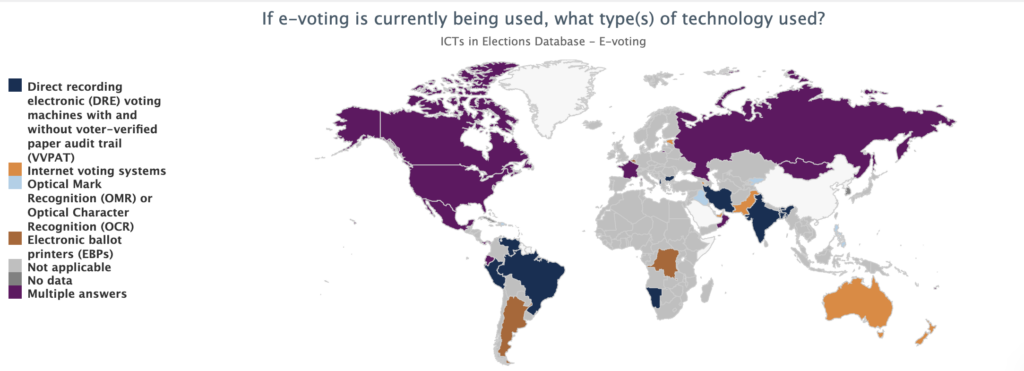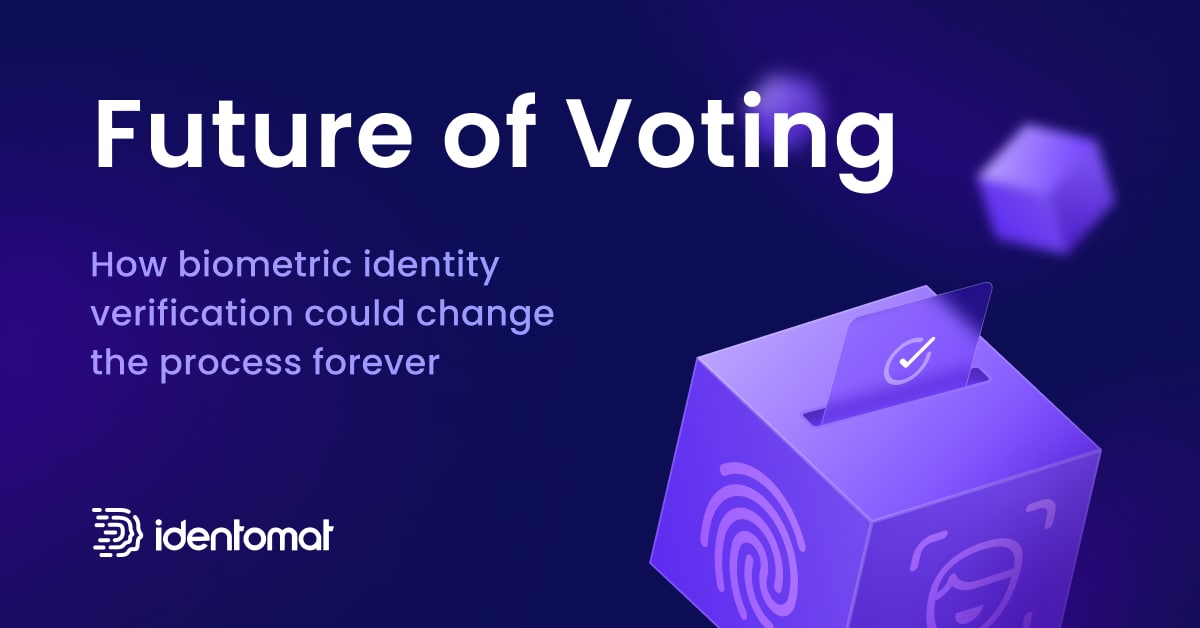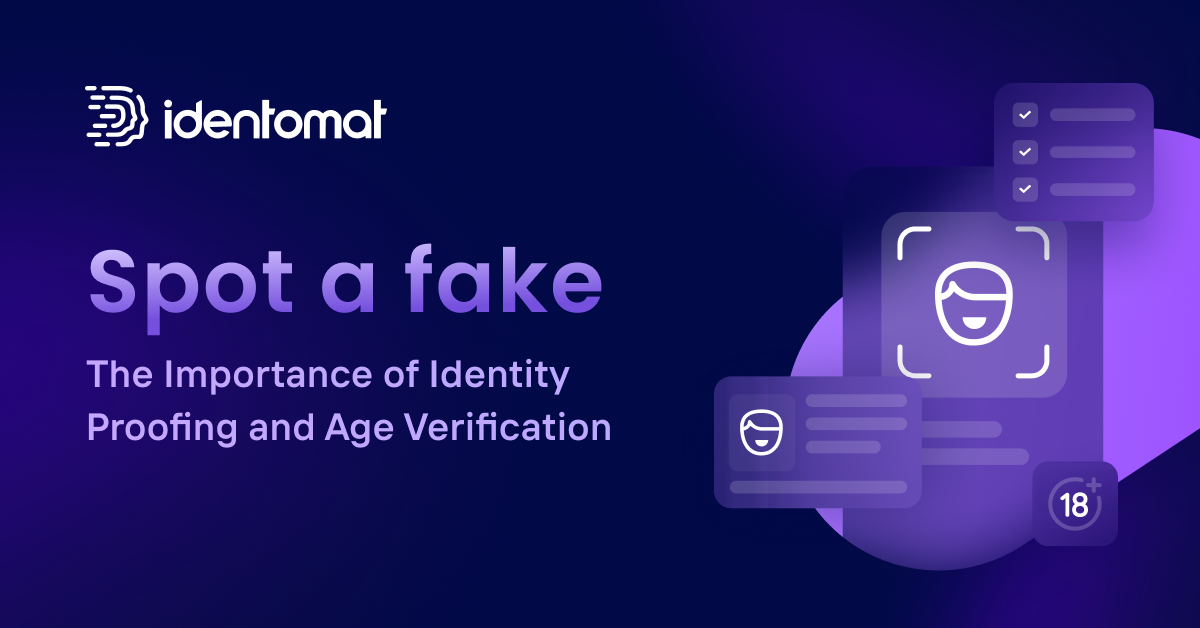As Americans head to the voting polls, it is important to consider how biometric technologies are impacting elections worldwide. While election officials across the globe have been utilizing e-voting for some time now, it has remained largely as an auxiliary. However, more and more countries are embracing technology for their national-level elections, and in 2005 Estonia became the first nation to hold a legal election over the Internet. Even more astonishing, 15 years after their first e-election, voter turnout has remained stellar and nearly half of Estonian voters opted to vote remotely during their 2019 parliament elections. In recent years, with much debate involving election integrity in the United States, we raise the question:
Is America in need of an electoral transformation?
To put it simply, yes.
Political experts consider the contemporary tipping point regarding election reform to have started during the 2000 election count when Republican George W. Bush lost the popular vote to Democrat Al Gore but defeated his opponent in the electoral college. Public concerns deepened when several major problems were observed in the 2016 and 2020 presidential campaigns as well. These complications have corroded public trust in election legitimacy and have overall resulted in worsening political party polarization. It’s safe to say that our basic voting procedures need to evolve, and with reform, identity and age verification solutions would be essential to every phase of the voting process, to ensure healthy election goals and promote fair and free elections.
The MANY challenges involved with a manual voting system
Voter Identification

Currently, challenges involving ID and registration requirements are preventing millions of eligible Americans from voting. For example, the critics argue that a voting law in Texas known as Senate Bill 1 discriminated against voters of color, and insisted that it was passed with a discriminatory purpose.
The Texas Tribune spelled out the implications of the new law: “When voting by mail, the new law required voters to write their driver’s license number, personal ID number, or the last four digits of their social security number on their mail ballot application and mail ballot envelope– whichever number they originally used to register.”
Besides the challenge of remembering the original registration numbers, advocates are also outraged by the lack of resources available to elderly voters and voters with health conditions or impairments, translators for voters native to different languages, and the plight of those unable to attend in-person elections due to economic disparity. Voting should be a pleasant experience for all those eligible, and remote voting could renew a sense of confidence in voters of all backgrounds. The safety and integrity of the election process can be improved without compromising citizens’ rights to vote. AI-powered KYC and identity verification are reliable, speedy, and actively prevent fraud– all important factors for a sound election. Identomat’s end-to-end identity verification solution includes active liveness check, selfie match, PEP lists check, and ID validity checks, and currently recognizes over 200 different languages. Applying biometric technology to the election process would militate risk and would encourage a safer, more trustworthy election.
Perceived Risk of Voter Fraud

Politicians at all levels and with different parties repeatedly have (and falsely) claimed that past elections were marred by extreme numbers of people voting illegally. However, extensive research has proven that voter fraud and voter impersonation are extremely infrequent, if almost virtually nonexistent. Researchers found that most times when mistakes were made during the electoral process, there were clerical errors performed by a voting administrator, a typo written by the voter themselves, or just bad matching. Yet these rampant allegations of fraud are making it more difficult for millions of eligible Americans to vote.
Types of potential fraud
- Voter registration fraud: “Someone registering to vote or registering someone else to vote using a fictional name or without the person’s consent.” (Ballotpedia)
Integrating a fool-proof KYC solution into the election process could erase claims of registration fraud. AI-generated KYC could easily able to detect when a fraudulent person is actively pretending to be someone else and would be able to sense when an unavailable address is being used during registration and report it. The technology would also effectively reject registration and votes cast by dogs (not kidding).
- Absentee/mail-in ballot vote fraud: “When an individual commits fraud via absentee or mail-in ballot, such as trying to vote more than once, attempting to vote as someone else, or attempting to vote despite being aware of their ineligible status.“ (Ballotpedia)
- Ballot stuffing: “When there’s a greater number of ballots cast or submitted compared to the number of people who legitimately voted.“ (Ballotpedia)
Voters are only allowed to cast one vote during an election and the punishment for double-voting is steep, leading to federal charges and possible jail time. While each state has its own set of laws regarding double-voting, KYC technology would notice when a person attempts to vote more than once.
- Voter impersonation: “Type of vote fraud in which a person claims to be someone else when casting a vote.” (Ballotpedia)
Banking-grade Identity verification could greatly impact America’s voting system, fighting against fraud and presenting trustworthy results, all to promote free and fair elections. For example, KYC would also be able to detect when a vote is cast in the name of a deceased person and would be able to reject the fraudster, thanks to liveness detection.
- Felon vote fraud: “When a convicted felon casts a ballot in a state in which they are not eligible, due to state laws.“ (Ballotpedia)
Currently, laws in 48 states prohibit people with felony convictions from voting. The Sentencing Project estimates that 4.6 million Americans are barred from voting due to these laws, representing 2 percent of the total voting population in the US. Identity verification could detect the conviction in a background check.
- Voter suppression: “Policies and tactics limiting eligible citizens to cast ballots in an election.” (Ballotpedia)
Remote voting offers the opportunity to limit voter suppression, by having advanced ways of verifying someone’s identity and eligibility, more than just a physical piece of identification. Allowing a remote environment for voting would eliminate the struggle of getting to a polling place, dealing with poorly trained staff, navigating language barriers, and resolve other voter challenges at the polls.
- Fraudulent signatures: “A fraudulent signature is a signature on a petition in support of a ballot measure or candidate seeking to qualify for the ballot that suffers from one or more fatal flaws introduced by either the circulator or the signer.“ (Ballotpedia)
Forgery detection technology would sense a fake signature, with algorithms able to recognize patterns, accepting signatures from the intended person.

Integrating an AI-generated identity verification solution into the election process would eliminate the small chance of fraud that does exist in the system and would put the rumors of voter fraud to bed. The banking grade level of accuracy and performance of Identomat could prevent bad matching, and offers the chance to put a complete stop to actors trying to outsmart the democratic system. Americans need and deserve a system in which it is easy to vote and that it is impossible to cheat. Full digital identity proofing and KYC compliance would resolve a number of the challenging issues that the current manual voting system has.
According to Pew Research, voting by internet is used in four countries: Armenia, Canada, Estonia, and Switzerland. However, as the Estonian President, Kersti Kaljulaid said, the Internet voting system utilized in her country cannot be simply copied and pasted into other countries.

““Every state has a different culture… This culture prevails also when you create your digital state. You need to find your own solutions which will convince your own people to use digital [methods].”
– Kersti Kaljulaid, President of Estonia
Prominent Data Loss

Maintaining voter rolls is a mess. The process of deleting names from registration lists results in many voters learning that they are no longer registered to vote when they arrive at the polls. According to Ballotpedia, at least 17 million people were removed from voter registration lists from 2016 to 2018. The process is performed allegedly for the sake of organization, as American voters die, move, or become ineligible. Critics worry about the deletion process being as secretive as it is. In general, for many reasons, manual voting is prone to data loss. With KYC technology, you’ll find resilient risk management processes and compliance. To implement e-voting, we are going to need software and an identity verification solution we can trust.
If biometric technology was included in election reform it would:

“Election technology must be introduced very carefully. It must be tested to fulfill its functional role, and more importantly, that it wouldn’t do things it is not supposed to do.”
– Liisa Past, Election technology and cybersecurity expert
Every vote is sacred and it should be protected. Legitimate voters should be able to vote privately, without fear of being harassed. They should be able to feel confident in the integrity of their vote, that it cannot be lost, stolen, or altered. Fraud protection is used by many industries worldwide, why not apply it toward our democracy? For the future of America, we need a transparent voting system in which fraud can be easily detected and allegations of fraud can be easily dispelled.
How to integrate biometric tech into elections
Administering elections is massively complex and challenging, as each territory has its own legality procedures and follows their own unique operating framework. Naturally, the biggest hesitation is making sure that things run smoothly and that bad actors aren’t able to hack a system and alter election results. Companies around the world are hard at work to modernize the voting experience and protect the sanctity of a vote. It is important to identify and mitigate vulnerabilities within the e-voting process, where voter’s uncertainties can be exploited by bad actors, and an identity verification solution would be essential with reform, ensuring that there is a voting solution for all people. Experts are integrating more optimal logistics, implementation, maintenance, and security practices for all stages of the voting process.
Voting software industry leader Smartmatic already has 1.95 million secure, election-ready devices deployed worldwide, and in 2020, they conducted the largest election project in US history. They had implemented their system in Los Angeles county, the largest voting jurisdiction in the US, making voting easier for all, but especially for voters with disabilities and those with limited English proficiency.
In this conflicted political climate, an electoral transformation in America is necessary for the future of democracy. Considering the rising trend of using technology, the end-to-end verification solution, and the cost-effectiveness, i-voting is going to make an impact on the world. Identity verification is going to be an integral part of the reform that is going to restore a voter’s confidence and give them the power they so rightfully deserve.
As Abraham Lincoln once said, “Elections belong to the people. It’s their decision. If they decide to turn their back on the fire and burn their behinds, then they will just have to sit on their blisters. “




